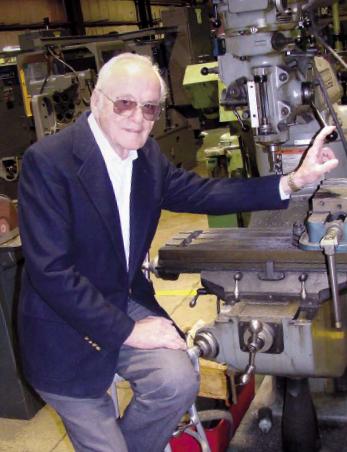Interview by Noah Graff
Today’s Machining World Archives April 2009 Volume 5 Issue 04

Albert Albrecht worked in the machine tool industry for 57 years and recently finished a book entitled An American Machine Tool Industry: It’s History, Growth & decline. He began writing in earnest after a walk through IMTS 2008, which confirmed for him the suspicion that 85 percent of modern, successful machine tool builders were foreign.
How did you get into the machine business?
AA: My dad and uncles were in the industry. If I had gone in another direction I probably would have been put out of the family. In those days not everyone went to high school, you did an apprenticeship with the tool and die makers. You would spend 8,000 hours in an apprenticeship and then you could go out as a certified tool and die maker.
What were the “golden years” in American machine tool building?
AA: The golden years were from about 1940-1982, when there were 154 American machine tool builders. America started out exporting machine tools because they were better and had better technology than you could get in Europe. People wanted U.S. technology. In 1982 we lost that to Japan, and we’ve never really recovered—at that time we were $5 billion in production and it dropped to $1.9 billion. That was the first recession—it took us 15 years to recover. 2003 was another extremely devastating period with a repeat of 1982’s drop. We’re at $3.3 billion right now, we still haven’t come all the way back.
Who are the companies producing in the U.S. today?
AA: This is one of our problems—we have an industry that is made up of only six truly international companies—MAG, Hardinge, Gleason, Minster, Haas and Moore. Japan and Germany are number one and two as exporters. 112 of the 145 companies that were alive during the golden years have closed their doors. That’s an estimated loss of $4.3 billion and around 50,000 jobs.
What caused the decline?
AA: The economic ups and downs of the business. One of the problems in the industry has been the availability of financing from banks. Banks haven’t always been kind to it—they see it as a high-risk business. This led to consolidations and mergers and a reduction in the size of the industry. Also, the conglomerates, which made a lot of acquisitions in the 1940s and 1950s when the companies were attractive, drained them of cash and dumped them off for liquidation. One of the problems we have today is that we talk about creating jobs, but nobody speaks about manufacturing or the loss of the industrial base in this country.
Who were the pioneers of American machine tool building?
AA: Warner Swasey, Cincinatti—they were the innovators, the real machine tool people. They didn’t think they were doing anything [special], they were just doing a job. But in doing that job they were producing a quality product with innovation ahead of what was already out there, and they built companies on it. When those companies were sold off machine tool people did not take over. They were MBAs and were only looking at the bottom line. They were interested in cash flow and what the companies could produce, not in the long-term. The original owners were dedicated to the business, had long-term objectives and loved the product they produced. I was one of those people. I was part of that generation.
What’s your goal in writing this book?
AA: Having been a person who was part of the industry—and there are not too many of us left—I think the story of the industry’s growth and its importance to the country needs to be told. More important than anything else is establishing a business environment today that will encourage manufacturing and the recovery of our industrial base. Not just in high-tech industries, but the base of manufacturing. The machine tool industry is no longer a dirty, grubby industry—it’s clean floors, high-tech and computers. Yet we tell our young people, “Manufacturing, no. You want to be a doctor or lawyer.” I want this book to change the mindset of our country in regards to the importance of manufacturing. Yes, we can buy and consume goods, but one of the things we don’t realize is that if we buy [foreign] machine tools, even if those tools are produced in this country, the profits and earnings go back to Japan.
